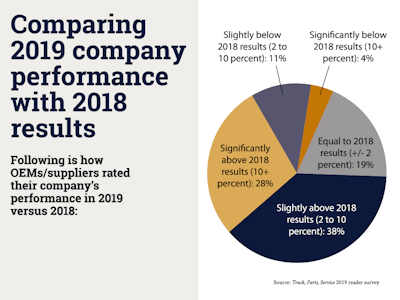
Volvo Trucks North America says 2018 and 2019 were two very good years for the industry as a whole, but were not free of challenges.
“We had substantial production constraints due to supply chain shortages in 2018 and the beginning of 2019. The industry backlog has also been at record levels and we did see many fear-of-missing-out orders in 2018. That, of course, led to even longer lead times, and eventually it came to a halt in November/December of 2018,” says Magnus Koeck, vice president, marketing and brand management, Volvo Trucks North America.
“Now the industry has substantial dealer inventory, which is a top priority for all OEMs. The market now is very competitive and we will see lower order intake numbers going forward,” Koeck says.
Like Volvo Trucks, the last two years were strong for Daimler Trucks North America (DTNA), says Richard Howard, senior vice president, sales and marketing.
“I call the past couple of years a megacycle and it certainly had our team in overdrive working to keep up with the demand from our customers. Coming off this megacycle, we’re seeing the order activity normalize at healthy levels,” Howard says.
As part of Paccar’s third quarter earnings report in October 2019, Gary Moore, executive vice president, says economic growth in the U.S., 50-year-low unemployment and strong consumer spending generated freight tonnage growth of 4.2 percent in 2019.
“The superior operating performance of Peterbilt and Kenworth trucks enhances our customers’ profitability,” Moore adds.
 Click to enlarge.
Click to enlarge.Paccar reported net sales and financial services revenues of $19.48 billion for the first nine months of 2019 compared with $17.22 billion in 2018. The company reported new truck deliveries of 90,600 in the U.S. and Canada during the nine months ended Sept. 30, 2019, compared with 78,500 trucks during the same period in 2018.
Navistar International Corp. last month reported net income of $221 million for fiscal year 2019, compared with net income of $340 million for the previous year. Adjusted net income for FY 2019 increased 29 percent to $423 million versus $327 million in 2018.
“With a proven track record of managing costs and improving operating results, Navistar is in a much better position than in the past to do well even during cyclical downturns,” says Troy A. Clarke, Navistar chairman, president and CEO.
“We are taking actions to adjust our business to current market conditions, including reducing production rates and [selling, general and administrative] expenses while restructuring our global and export operations. Building on the strong gains achieved over the last several years, Navistar has a clear roadmap in place for sustained growth that will set it apart from the industry,” Clarke says.
Trailer OEMs also reported successful years in 2018 and 2019. While a couple trailer OEMs saw a downtick in 2019, that wasn’t the trend for all of them.
“All products have seen strong demand; 2018 and 2019 were years that if you had it, you could sell it,” says David Giesen, vice president – sales, Stoughton Trailers. “In both years, we have experienced record long backlogs driven by much higher than average demand.”
Giesen says increasing costs in materials and components leveled off, which is good for customers by keeping the pricing environment more stable. Other challenges to successful years were shortages among the component suppliers and finding labor in a strong economy with low unemployment, he says.
Strick Trailers President Stephen Burns described the last two years as “very good” with “steady volume,” adding sales were off slightly in the third quarter of 2019.
“Coming into 2018, our backlog had increased to over 2,000 trailers and maintained that level throughout the year, even with record-level build rates,” says Dave de Poincy, president and chief operating officer, East Manufacturing. He adds 2018 was East’s biggest year in 50 years, building and shipping more than 3,600 trailers.
“In February of 2019 the quotes and orders began to soften for flatbed trailers and by April backlog began dropping significantly,” de Poincy says. “The dump segment never really increased to anticipated levels for the normal spring business. Backlog has now dropped below normal levels and is putting pressure on material lead times to maintain production levels.”
Looking at 2020
DTNA Chief Customer Experience Officer Paul Romanaggi says 2019 was the company’s best year for parts availability since 2016, with the launch of its 10th North American distribution center, allowing for 90 percent of dealer orders to be on a dedicated delivery service route for 12-hour delivery.
“In early 2020 we’ll further expedite the parts ordering and delivery process for our customers with the launch of our e-commerce platform, Excelerator,” Romanaggi says.
Koeck says it’s no surprise the industry is entering a different business climate after a couple of very good years. That said, historically, a 240,000-truck total market “is still not a bad market and we still see companies replacing trucks in their fleets, but they will most likely not grow their businesses during 2020.”
He adds the long-haul segment is the segment that drops first and that does affect Volvo because its core product lines are long-haul models.
 Click to enlarge.
Click to enlarge.“On the other hand, it seems the vocational business will hold up pretty well in 2020, while the regional-haul segment will be somewhere in between. The amount of inventory will continue to keep the market competitive during the first months of 2020, and we will need to manage through that,” Koeck says.
Paccar has reported “Class 8 truck industry retail sales in 2020 for the U.S. and Canada are estimated to be in a range of 230,000 to 260,000 vehicles. “A solid replacement vehicle market,” Moore says.
In Navistar’s most recent earnings report, the company stated industry retail deliveries of Class 6-8 trucks and buses in the U.S. and Canada are forecasted to be in the range of 335,000 to 365,000 units, with Class 8 retail deliveries between 210,000 and 240,000 units.
Giesen says 2020 appears to be a much more normal demand environment for Stoughton Trailers, with projected volumes that come closer to industry averages.
East dealers are heavily stocked at this point, de Poincy says, “and, unless there is a big buy at the end of [2019] for tax purposes, it will delay future stock orders from these dealers in 2020.”
In 2020, Burns says Strick will continue adding more customized products to its lineup and working to bridge the gap between manufacturer and dealer. For example, the company rolled out its StrickVantage dealer program last November. “Our focus will be on dealers whose level of commitment is aligned with Strick’s mission to understand customer expectations, needs challenges and opportunities,” he says.
What lies ahead
The upcoming elections likely make it difficult for many in the truck and trailer industry to more accurately forecast business in 2020 and beyond.
“The political unrest in the nation is not helping anyone. Uncertainty always results in delayed forecasts and pre-ordering by the fleet accounts. The fact that the election is at the end of 2020 will also negatively affect our business,” de Poincy says. “Uncertainty is the result through Q1 of 2021. I don’t see orders returning to normal levels until Q2 2021.”
Regardless of elections and a shaky international trade climate, among other factors, OEMs continue to move the industry forward.
For example, Volvo says the industry will continue to explore electrification and connectivity, and the interest among customers is huge.
“We are still in very early stages when it comes to electrification, especially fully electric Class 8 trucks. By the end of 2020 we will commercialize our VNR Electric truck model,” Koeck says.
Regarding connectivity, Volvo is continuously developing services to increase customers’ uptime and transport efficiency. Koeck says remote programming with over-the-air downloading of parameter updates is “game-changing for our industry and we are definitely in the forefront in this area.”
Another trend in the industry that is on everyone’s minds is automation, he says. “We are investing significantly in terms of research and development. We also have several commercial pilots happening around the world with different levels of automation.”
DTNA plans to launch in early 2021 the Detroit DD15 Gen 5, which will deliver greater efficiency, the company says.
“With regard to safety, we’re putting Detroit Assurance 5.0 into production with our Enhanced Cascadia to deliver a suite of systems to enable the industry’s first SAE Level 2 driving experience for our customers and drivers. The active safety systems can be a game-changer for fleet safety and driver comfort,” Howard says.
This is an industry that never rests on its laurels, nor is it content with the status quo. The near future is shaping up to be exciting times and Trucks, Parts, Service will continue to be there to tell you about it.
State of the Industry, Part V: Dealerships address company plans and trends for 2020












